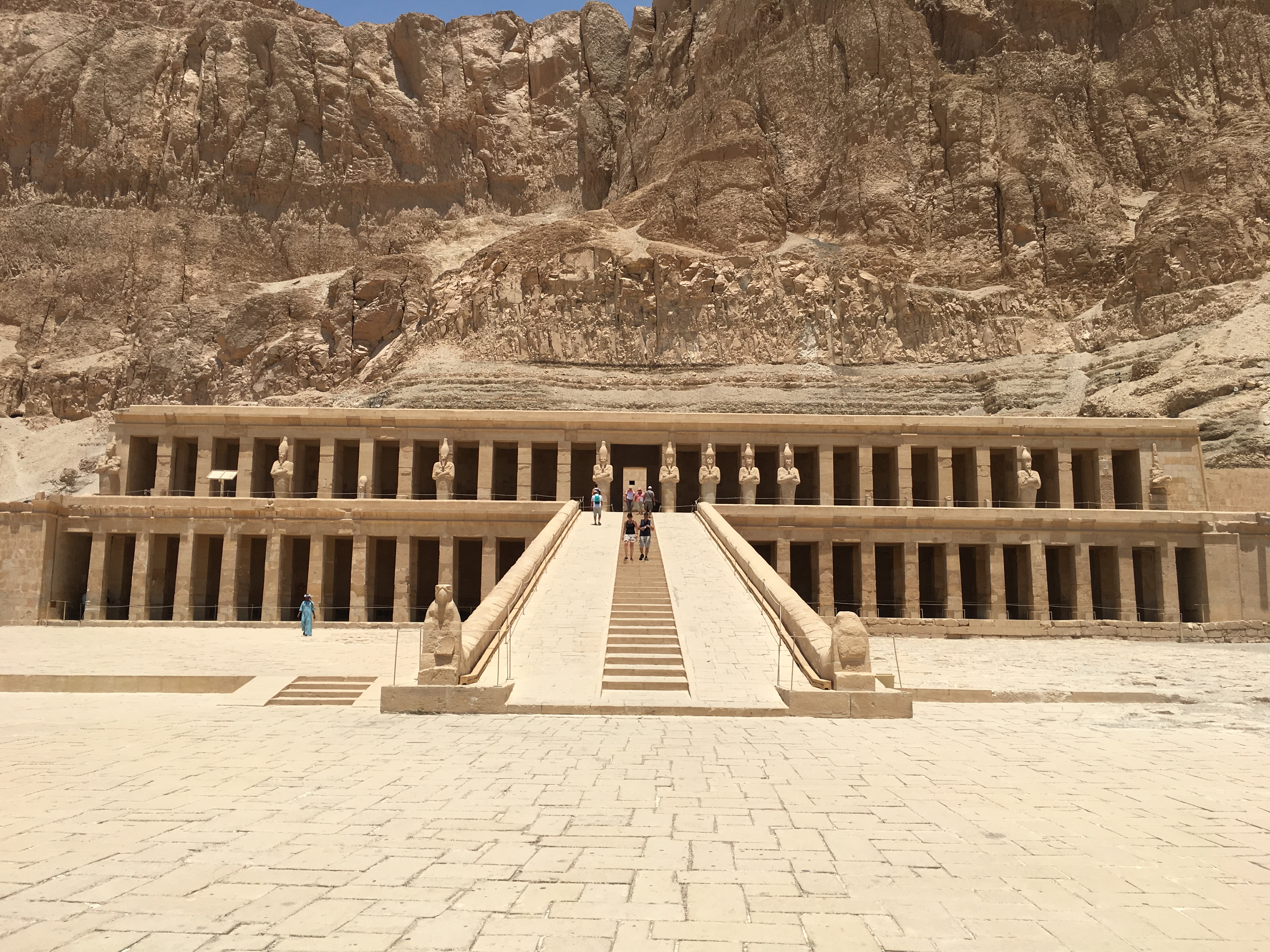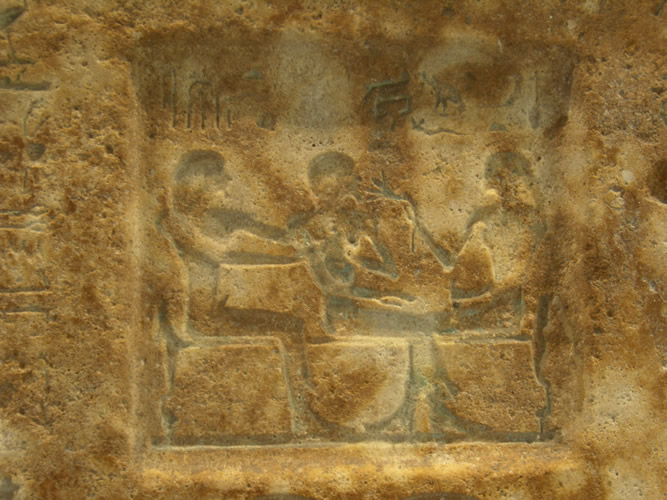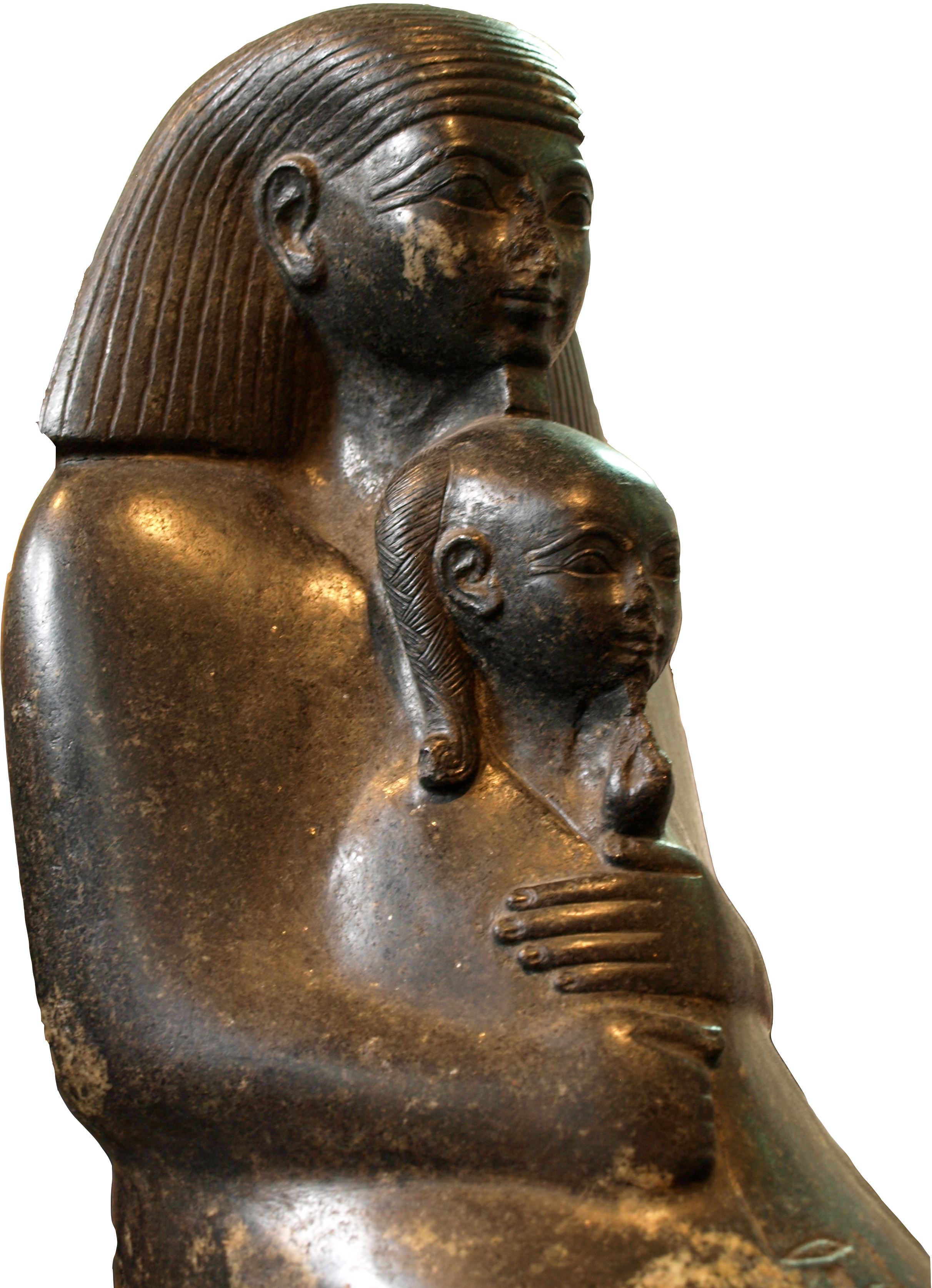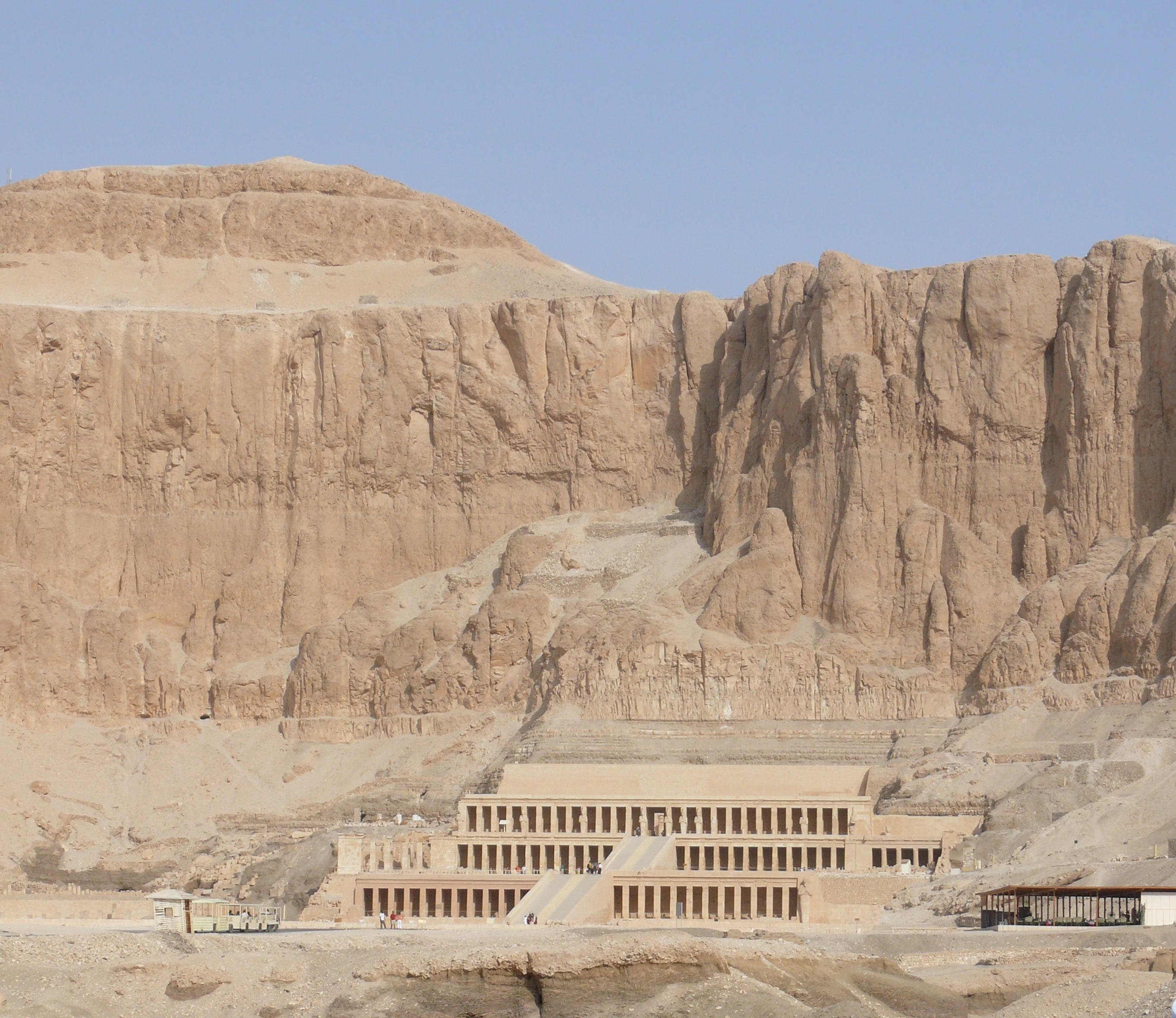|
Senenmut
Senenmut ( egy, sn-n-mwt, sometimes spelled Senmut, Senemut, or Senmout) was an 18th Dynasty ancient Egyptian architect and government official. His name translates literally as "mother's brother." Family Senenmut was of low commoner birth, born to literate provincial parents, Ramose and Hatnofer (or "Hatnefret") from Iuny (modern Armant). Senenmut is known to have had three brothers (Amenemhet, Minhotep, and Pairy) and two sisters (Ahhotep and Nofrethor). However, only Minhotep is named outside chapel TT71 and tomb TT353, in an inventory on the lid of a chest found in the burial chamber of Ramose and Hatnofer. More information is known about Senenmut than many other non-royal Egyptians because the joint tomb of his parents (the construction of which Senenmut supervised himself) was discovered intact by the Metropolitan Museum in the mid-1930s and preserved. Christine Meyer has offered compelling evidence to show that Senenmut was a bachelor for his entire life: for instance ... [...More Info...] [...Related Items...] OR: [Wikipedia] [Google] [Baidu] |
TT71
Theban Tomb TT71 is located in the Theban Necropolis, on the west bank of the Nile, opposite to Luxor. It was the tomb chapel of Senenmut, who was the steward and architect of Hatshepsut. The chapel is located in the necropolis area around Sheikh Abd el-Qurna. Previously (for about 100 years) the tomb was accessible and for most of this time the target of numerous investigations and intrusions, although early on already heavily destroyed. The tomb was visited already early. In the first half of the nineteenth century, John Gardner Wilkinson, Robert Hay and J. Wild copied scenes, although the decoration was already badly destroyed. Richard Lepsius (1842–45) took the false door to Berlin and copied some inscribed bricks. Only in 1906 Kurt Sethe copied all inscriptions. In 1930–31 Herbert Winlock cleared the whole tomb. Winlock found the fragments of a smashed sarcophagus. Today the tomb chapel's decoration is almost totally gone. With its dimensions it is one of the biggest ... [...More Info...] [...Related Items...] OR: [Wikipedia] [Google] [Baidu] |
Ramose And Hatnofer
Ramose was the father and Hatnofer the mother of Senenmut, one of the most important state officials under the reign of the Egyptian queen Hatshepsut in the Eighteenth Dynasty of Egypt. The commoner origins of Ramose and the rise of his son Senenmut were long considered to be prime examples of high social mobility in New Kingdom Egypt. For instance, almost nothing is known of Ramose's origins, but he seems to have been a man of modest means—anything from a tenant peasant or farmer, to an artisan or even a small landowner. When Ramose died he was a man aged 50–60 (based on the dental evidence).Peter F. Dorman, In: The Theban Necropolis, Past, Present and Future, p. 32, note 17 Hatnofer was an elderly lady, with grey or even white hair. They are believed to have been born at Armant, a town only south of Thebes within Upper Egypt presumably during the reign of Ahmose I, the founder of Egypt's illustrious 18th dynasty. Tomb of Ramose and Hatnofer Ramose is known from a few co ... [...More Info...] [...Related Items...] OR: [Wikipedia] [Google] [Baidu] |
Neferure
Neferure (or Neferura) was an Ancient Egypt, Egyptian princess of the Eighteenth Dynasty of Egypt. She was the daughter of two pharaohs, Hatshepsut and Thutmose II. She served in high offices in the government and the religious administration of Ancient Egypt. Family Neferure was the only known child of Thutmose II and his great royal wife Hatshepsut. She was the granddaughter of Thutmose I and the half-sister of Thutmose III. It has been suggested that Neferure married her half-brother, but there is no conclusive evidence of such a marriage. A king’s son named Amenemhat (son of Thutmose III), Amenemhat (B) was installed as Overseer of the Cattle in year 24 of the reign of Thutmose III, and this prince may have been a son of Neferure. It has been pointed out however, that if Neferure had become a great royal wife of Thutmose III, she would have been attested with that title, which is not known to be the case. Life Neferure was born during the reign of Thutmose II. In Karnak ... [...More Info...] [...Related Items...] OR: [Wikipedia] [Google] [Baidu] |
Deir El-Bahri
Deir el-Bahari or Dayr al-Bahri ( ar, الدير البحري, al-Dayr al-Baḥrī, the Monastery of the North) is a complex of mortuary temples and tombs located on the west bank of the Nile, opposite the city of Luxor, Egypt. This is a part of the Theban Necropolis. The first monument built at the site was the mortuary temple of Mentuhotep II of the Eleventh Dynasty. It was constructed during the 21st century BC. During the Eighteenth Dynasty, Amenhotep I and Hatshepsut also built extensively at the site. Mortuary temple of Nebhepetre Mentuhotep Mentuhotep II, the Eleventh Dynasty king who reunited Egypt at the beginning of the Middle Kingdom, built a very unusual funerary complex. His mortuary temple was built on several levels in the great bay at Deir el-Bahari. It was approached by a 16-metre-wide (50-ft) causeway leading from a valley temple which no longer exists. The mortuary temple itself consists of a forecourt and entrance gate, enclosed by walls on three sides, a ... [...More Info...] [...Related Items...] OR: [Wikipedia] [Google] [Baidu] |
Hatshepsut
Hatshepsut (; also Hatchepsut; Egyptian: '' ḥꜣt- špswt'' "Foremost of Noble Ladies"; or Hatasu c. 1507–1458 BC) was the fifth pharaoh of the Eighteenth Dynasty of Egypt. She was the second historically confirmed female pharaoh, after Sobekneferu. (Various other women may have also ruled as pharaohs or at least regents before Hatshepsut, as early as Neithhotep around 1,600 years prior.) Hatshepsut came to the throne of Egypt in 1478 BC. As the principal wife of Thutmose II, Hatshepsut initially ruled as regent to Thutmose III, a son of Thutmose II by another wife and the first male heir. While Thutmose III had inherited the throne at about two years old, Hatshepsut continued to rule by asserting her lineage as the daughter and only child of Thutmose I and his primary wife, Ahmose. Her husband Thutmose II was the son of Thutmose I and a secondary wife named Mutnofret, who carried the title 'King's daughter' and was probably a child of Ahmose I. Hatshepsut and Thutmos ... [...More Info...] [...Related Items...] OR: [Wikipedia] [Google] [Baidu] |
Mortuary Temple Of Hatshepsut
The mortuary temple of Hatshepsut (Egyptian: ''Ḏsr-ḏsrw'' meaning "Holy of Holies") is a mortuary temple built during the reign of Pharaoh Hatshepsut of the Eighteenth Dynasty of Egypt. Located opposite the city of Luxor, it is considered to be a masterpiece of ancient architecture. Its three massive terraces rise above the desert floor and into the cliffs of Deir el-Bahari. Her tomb, KV20, lies inside the same massif capped by El Qurn, a pyramid for her mortuary complex. At the edge of the desert, east, connected to the complex by a causeway lies the accompanying valley temple. Across the river Nile, the whole structure points towards the monumental Eighth Pylon, Hatshepsut's most recognizable addition to the Temple of Karnak and the site from which the procession of the Beautiful Festival of the Valley departed. The temple's twin functions are identified by its axes: its main east-west axis served to receive the barque of Amun-Re at the climax of the festival, while its no ... [...More Info...] [...Related Items...] OR: [Wikipedia] [Google] [Baidu] |
Djeser-Djeseru
The mortuary temple of Hatshepsut (Egyptian: ''Ḏsr-ḏsrw'' meaning "Holy of Holies") is a mortuary temple built during the reign of Pharaoh Hatshepsut of the Eighteenth Dynasty of Egypt. Located opposite the city of Luxor, it is considered to be a masterpiece of ancient architecture. Its three massive terraces rise above the desert floor and into the cliffs of Deir el-Bahari. Her tomb, KV20, lies inside the same massif capped by El Qurn, a pyramid for her mortuary complex. At the edge of the desert, east, connected to the complex by a causeway lies the accompanying valley temple. Across the river Nile, the whole structure points towards the monumental Eighth Pylon, Hatshepsut's most recognizable addition to the Temple of Karnak and the site from which the procession of the Beautiful Festival of the Valley departed. The temple's twin functions are identified by its axes: its main east-west axis served to receive the barque of Amun-Re at the climax of the festival, while its no ... [...More Info...] [...Related Items...] OR: [Wikipedia] [Google] [Baidu] |
High Steward (Ancient Egypt)
The high steward (also called chief steward or great overseer of the house; Egyptian: ''imi-r pr wr'') was an important official at the royal court in Ancient Egypt in the Middle Kingdom and in the New Kingdom. He was the main person in charge of the estates supplying the palace and the royal residence with food. The office appears in the 11th Dynasty. To the earliest title holders belong Henenu and Meketre. After the vizier and the treasurer this was the most important office at the royal court; important title holders of the 12th Dynasty were Siese and Khnumhotep III, both were later in their career appointed vizier. The title was still very important in the New Kingdom and was in this period often called high steward of the king. An important title holder of the New Kingdom was Senenmut under Hatshepsut, other include Wadjetrenput serving under the same queen. Chief steward of the God's Wife During the 25th and 26th dynasties, the role of God's Wife of Amun greatly ro ... [...More Info...] [...Related Items...] OR: [Wikipedia] [Google] [Baidu] |
Peter Dorman
Peter FitzGerald Dorman (born 1948) is an epigrapher, philologist, and Egyptologist. Recently a professor of history and archaeology at the American University of Beirut (AUB), he served as the 15th President of the university from 2008 to 2015. He spent most of his career as a professor and chair in the department of Near Eastern Languages and Civilizations (NELC) of the University of Chicago, and was director of Chicago House in Luxor, the Epigraphic Survey field project of the Oriental Institute. He is presently a professor emeritus of the University of Chicago. Career Dorman is known for his work as a historiographer, epigrapher and philologist, and is a leader in the study of the ancient Near East. He is the author and editor of several major books and many articles on the study of ancient Egypt and is probably best known for his historical work on the reign of Hatshepsut and the Amarna period. His most recent monograph, ''Faces in Clay: Technique, Imagery, and Allusion in a ... [...More Info...] [...Related Items...] OR: [Wikipedia] [Google] [Baidu] |
Thebes, Egypt
, image = Decorated pillars of the temple at Karnac, Thebes, Egypt. Co Wellcome V0049316.jpg , alt = , caption = Pillars of the Great Hypostyle Hall, in ''The Holy Land, Syria, Idumea, Arabia, Egypt, and Nubia'' , map_type = Egypt , map_alt = , map_size = , relief = yes , coordinates = , location = Luxor, Luxor Governorate, Egypt , region = Upper Egypt , type = Settlement , part_of = , length = , width = , area = , height = , builder = , material = , built = , abandoned = , epochs = , cultures = , dependency_of = , occupants = , event = , excavations = , archaeologists = , condition = , ownership = , management = , public_access = , website = , notes = , designation1 = WHS , designation1_offname = Ancient Th ... [...More Info...] [...Related Items...] OR: [Wikipedia] [Google] [Baidu] |
Nile River
The Nile, , Bohairic , lg, Kiira , Nobiin: Áman Dawū is a major north-flowing river in northeastern Africa. It flows into the Mediterranean Sea. The Nile is the longest river in Africa and has historically been considered the longest river in the world, though this has been contested by research suggesting that the Amazon River is slightly longer.Amazon Longer Than Nile River, Scientists Say Of the world's major rivers, the Nile is one of the smallest, as measured by annual flow in cubic metres of water. About long, its covers eleven countries: the |
Mortuary Temple Of Hatshepsut, Egypt
A morgue or mortuary (in a hospital or elsewhere) is a place used for the storage of human corpses awaiting identification (ID), removal for autopsy, respectful burial, cremation or other methods of disposal. In modern times, corpses have customarily been refrigerated to delay decomposition. Etymology and lexicology The term ''mortuary'' dates from the early 14th century, from Anglo-French ''mortuarie'', meaning "gift to a parish priest from a deceased parishioner," from Medieval Latin mortuarium, noun use of neuter of Late Latin adjective mortuarius "pertaining to the dead," from Latin ''mortuus'', pp. of ''mori'' "to die" (see mortal (adj.)). The meaning of "place where the deceased are kept temporarily" was first recorded in 1865, as a euphemism for the earlier English term "deadhouse". The term ''morgue'' comes from the French. First used to describe the inner wicket of a prison, where new prisoners were kept so that jailers and turnkeys could recognize them in the futu ... [...More Info...] [...Related Items...] OR: [Wikipedia] [Google] [Baidu] |







